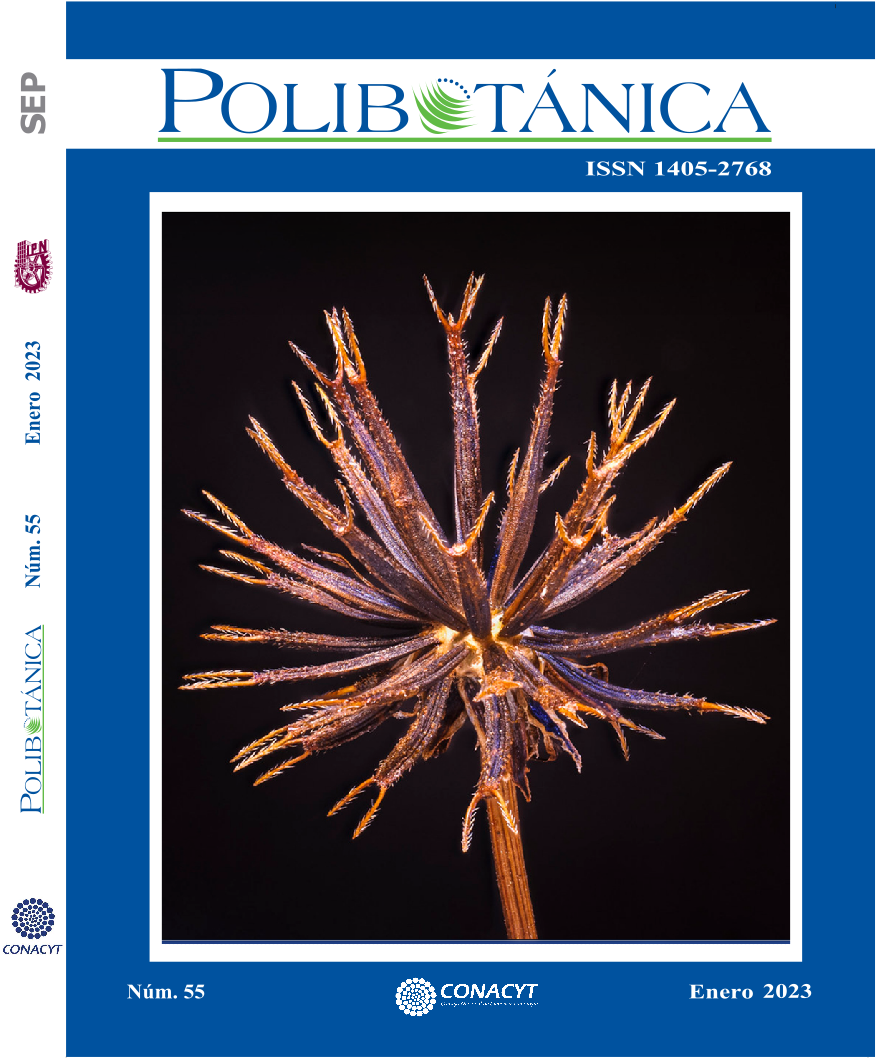Studies for the conservation and use of Chrysactinia mexicana A. Gray, an aromatic and medicinal plant native to Mexico
DOI:
https://doi.org/10.18387/polibotanica.55.10Keywords:
Chrysactinia mexicana, distribution, habitat, propagation, phenology, secondary metabolitesAbstract
One of the strategies to recognize the potential future use of aromatic and medicinal plants (AMPs) is to take into account the past uses and traditional knowledge of AMPs from indigenous and rural people. The general objective of this research is to document and generate information on Chrysactinia mexicana, which serves as a basis for its subsequent cultivation, use, and conservation. For the documentation of common names, traditional uses, diagnostic characters, secondary metabolites and bioactivity, an exhaustive review of scientific bibliographic resources was carried out, obtained from specialized academic search on the Internet. Both, the distribution map and the identification of the biotic and abiotic factors associated with the distribution of the species were generated using Geographic Information Systems (GIS). Information about the phenology, propagation strategies and habitat characteristics were collected in the field once a month, for of one year. Chrysactinia mexicana has a wide variety of common names which highlight the close link between the species and the inhabitants of the regions in which it originates. The use of its leaves, stems, and flowers has been noted to cure respiratory infections, skin infections, stomach pains, diarrhoea, fever, and rheumatism. It is distributed in the biogeographical provinces of the Chihuahuan Desert, Sierra Madre Oriental, and Trans-Mexican Volcanic Belt, showing a clear affinity to the Nearctic region and to arid and semi-arid zones. Its wide distribution indicates that it is a species with low habitat specificity. It spreads sexually through wind-dispersed achenes, while asexual propagation is via subterranean stolons. Although it presents a wide variety of secondary metabolites, the most notable compounds are the terpenes, specifically, piperitone, eucalyptol, linalyl acetate, α-terpineol, Sylvain and terpineol. The different bioproducts show positive results combatting bacteria, mycobacteria, fungi, and amoebae. It was also observed that the essential oil has insecticidal and nematicidal actions. More recent studies have shown positive results when used as an antidepressant and as a sexual behavior stimulant. Chrysactinia mexicana could have many potential uses in pharmaceutical, cosmetic, food, and pest control industries, however it is important to start with studies that aid to develop and establish its propagation and cultivation.
References
BDMTM. (2009). Biblioteca Digital de la Medicina Tradicional Mexicana. Universidad Nacional Autónoma de México e Instituto Nacional Indigenista.
Cabrera, J. A. (2015). Plantas medicinales del estado de Querétaro, México; con base a ejemplares de herbario. (p. 159). Facultad de Ciencias Naturales, Universidad Autónoma de Querétaro.
Cárdenas-Ortega, N. C., Juárez-Flores, B. I., Pinos-Rodríguez, J. M., & Aguirre-Rivera, J. R. (2011). Biocide effects of Chrysactinia Mexicana A. Gray. Plant-Phytochemicals in Animal Nutrition, November 2015, 119–134. https://doi.org/10.1055/s-2007-986995
Cárdenas-Ortega, N. C., Zavala-Sánchez, M. A., Aguirre-Rivera, J. R., Pérez-González, C., & Pérez-Gutiérrez, S. (2005). Chemical composition and antifungal activity of essential oil of Chrysactinia mexicana gray. Journal of Agricultural and Food Chemistry, 53(11), 4347–4349. https://doi.org/10.1021/jf040372h
Cassani, J., Ferreyra-Cruz, O. A., Dorantes-Barrón, A. M., Vigueras, R. M., Arrieta-Baez, D., & Estrada-Reyes, R. (2015). Antidepressant-like and toxicological effects of a standardized aqueous extract of Chrysactinia mexicana A. Gray (Asteraceae) in mice. Journal of Ethnopharmacology, 171, 295–306. https://doi.org/10.1016/j.jep.2015.05.055
Delgado, G., & Ríos, M. Y. (1991). Monoterpenes from Chrysactinia mexicana. Phytochemistry, 30(9), 3129–3131. https://doi.org/10.1016/S0031-9422(00)98268-2
Delgado, G., Rios, M. Y., & Rodriguez, C. (1993). Additional terpenoids from Chrysactinia mexicana. In Planta Medica (Vol. 59, Issue 5, p. 482). https://doi.org/10.1055/s-2006-959742
Domínguez, X. A., & Vázquez, G. (1985). Constituents from Chrysactinia mexicana. Journal of Natural Products, 48(4), 681–682.
ESRI. (2011). Environmental Systems Research Institute. ArcGIS Desktop: Release 10. Redlands, CA.
Estrada-Reyes, R., Ferreyra-Cruz, O. A., Jiménez-Rubio, G., Hernández-Hernández, O. T., & Martínez-Mota, L. (2016). Prosexual effect of chrysactinia mexicana A. Gray (Asteraceae), false damiana, in a model of male sexual behavior. BioMed Research International, 2016. https://doi.org/10.1155/2016/2987917
García-López, J. C., Álvarez-Fuentes, G., Pinos-Rodríguez, J. M., Jasso-Pineda, Y., Contreras-Treviño, H. I., Camacho-Escobar, M. A., López-Aguirre, S., Lee-Rangel, H. A., & Rendón-Huerta, J. A. (2017). Anti-inflammatory Effects of Chrysactinia mexicana Gray Extract in Growing Chicks (Gallus gallusdomesticus) Challenged with LPS and PHA. International Journal of Current Microbiology and Applied Sciences, 6(1), 550–562. https://doi.org/10.20546/ijcmas.2017.601.068
Gomez-Macias, E., Mellado-Bosque 1, M. A., Ascacio-Valdes, J. A., Aguirre-Arzola, V. E., Martinez-Avila, G. C. G., Aguilar, C. N., & Aaguilera-Carbo. (2019). Polyphenolic profile antioxidant potential and antimicrobial activity of Chrysactinia mexicana A. Gray (Hierba de san Nicolas). International Journal of Pharmacognosy, 6(12), 390–396.
Guerra-Boone, L., Álvarez-Román, R., Salazar-Aranda, R., Torres-Cirio, A., Rivas-Galindo, V. M., De Torres, N. W., González, G. M. G., & Pérez-López, L. A. (2013). Chemical compositions and antimicrobial and antioxidant activities of the essential oils from Magnolia grandiflora, Chrysactinia mexicana, and schinus molle found in northeast Mexico. Natural Product Communications, 8(1), 135–138. https://doi.org/10.1177/1934578x1300800133
Guevara, B. M. M., Torres, A., Rivas, V. M., Salazar, R., Waksman, N., & Pérez-López, L. A. (2011). Activity against Streptococcus pneumoniae of the essential oil and 5-(3-buten-1-ynyl)-2, 2′-bithienyl isolated from Chrysactinia Mexicana roots. Natural Product Communications, 6(7), 1035–1038. https://doi.org/10.1177/1934578x1100600728
Iannicelli, J., Guariniello, J., Álvarez, S. P., & Escandón, A. (2018). Traditional uses, conservation status and biotechnological advances for a group of aromatic / medicinal native plants from America. Boletin Latinoamericano y Del Caribe de Plantas Medicinales y Aromaticas, 17(5), 453–491.
Ibrahim, S. R. M., Abdallah, H. M., El-Halawany, A. M., & Mohamed, G. A. (2016). Naturally occurring thiophenes: isolation, purification, structural elucidation, and evaluation of bioactivities. Phytochemistry Reviews, 15(2), 197–220. https://doi.org/10.1007/s11101-015-9403-7
INEGI. (1985a). Conjunto de Datos Vectoriales Edafológicos Escala 1:250,000 Serie II, Continuo Nacional. Instituto Nacional de Estadística, Geografía e Informática.
INEGI. (1985b). Conjunto de Datos Vectoriales Geológicos Escala 1:250,000 Serie I, Continuo Nacional. Instituto Nacional de Estadística, Geografía e Informática.
INEGI. (2000). Conjunto de Datos Vectoriales de Climas. Escala 1:1,000,000 Serie I, Continuo Nacional. Instituto Nacional de Estadística, Geografía e Informática.
INEGI. (2001). Conjunto de Datos Vectoriales Fisiográficos. Escala 1:1,000,000 Serie I, Continuo Nacional. Instituto Nacional de Estadística, Geografía e Informática.
INEGI. (2013). Conjunto de Datos Vectoriales de Uso de Suelo y Vegetación. Escala 1:250,000 Serie 5, Capa unión. Instituto Nacional de Estadística, Geografía e Informática.
Juárez-Rosete, C., Aguilar-castillo, J., Juárez-Rosete, M., Bugarín-Montoya, R., Juárez-López, P., & Cruz-Crespo, E. (2013). Herbs and Medicinal Plants in Mexico : Tradition &. Bio Ciencias, 2(3), 119–129.
Magallán-Hernández, F., Alvarado, A., Ocampo, R., & Guerrero, L. (2015). Protocolos de propagación de plantas nativas aromáticas y medicinales con uso potencial en la industria farmacéutica y cosmética (p. 52).
Martínez, M. (1967). Las plantas medicinales de México (sexta). Librería y Ediciones Botas.
Medina-de la Cruz, O., Leal-Moralesb, C. A., Meza-Menchaca, T., Guillen, L., & Juárez-Flores, B. I. (2020). Universidad de Sonora. Biotecnia, XXIII(1), 28–35. http://biotecnia.unison.mx
Morrone, J. J. (2019). Regionalización biogeográfica y evolución biótica de México: encrucijada de la biodiversidad del Nuevo Mundo. Revista Mexicana de Biodiversidad, 90(0), 1–68. https://doi.org/10.22201/ib.20078706e.2019.90.2980
Muñeton, P. (2009). Plantas medicinales: un complemento vital para la salud de los mexicanos. Revista Digital Universitaria, 10(9), 2–9. http://www.revista.unam.mx/vol.10/num9/art58/int58.htm
Palma-Tenango, M., Soto-Hernández, M., & Aguirre-Hernández, E. (2017). Flavonoids in Agriculture. Flavonoids - From Biosynthesis to Human Health, August. https://doi.org/10.5772/intechopen.68626
Peña-Rodríguez, L. M., Durán-García, R., Vera-Ku, M., Fuentes-García, A., & Domínguez-Carmona, D. B. (2010). Recursos con potencial económico I Flora nativa como fuente potencial de nuevos fármacos. Biodiversidad y Desarrollo Humano En Yucatán. https://doi.org/https://www.cicy.mx/sitios/biodiversidad-y-desarrollo-humano-en-yucatan
Rzedowski, J. (2006). Vegetación de México (1a digital). Comisión Nacional para el conocimiento y Uso de la Biodiversidad. https://www.biodiversidad.gob.mx/publicaciones/librosDig/pdf/VegetacionMx_Cont.pdf
Standley, P. (1920). Trees and shrubs of Mexico (Vol. 23, Issue 1). Smithsonian Libraries. https://doi.org/https://doi.org/10.5962/bhl.title.15726
Villareal, J. Á. (2003). Familia Compositae: Tribu Tageteae. Flora Del Bajío y de Regiones Adyacentes, Fascículo, 769–783. http://inecolbajio.inecol.mx/floradelbajio/documentos/fasciculos/ordinarios/Compositae-Tageteae 113.pdf
Villarreal, M. L., Cardoso-Taketa, A., Ortíz, A., & Sharma, A. (2014). Biotecnología para producir medicinas de plantas mexicanas. Revista Digital Universitaria, 15(8), 1–15. http://www.revista.unam.mx/vol.15/num8/art62/%5CnBIOTECNOLOG�A
Villaseñor, J. L., & Redonda-Martínez, M. del R. (2009). El género Chrysactinia (Asteraceae, tribu Tageteae) en México. Revista Mexicana de Biodiversidad, 80(001), 29–37. https://doi.org/10.22201/ib.20078706e.2009.001.580
Waizel, J. (2010). Las plantas medicinales y las ciencias: una visión multidisciplinaria.
Zavala-Mendoza, D., Grasa, L., Zavala-Sánchez, M. Á., Pérez-Gutiérrez, S., & Murillo, M. D. (2016). Antispasmodic effects and action mechanism of essential oil of Chrysactinia mexicana A. Gray on rabbit ileum. Molecules, 21(783), 1–12. https://doi.org/10.3390/molecules21060783
Downloads
Published
Issue
Section
License

Polibotánica by Departamento de Botánica de la Escuela Nacional de Ciencias Biológicas del Instituto Politécnico Nacional se distribuye bajo una Licencia Creative Commons Atribución-NoComercial-CompartirIgual 4.0 Internacional.




















